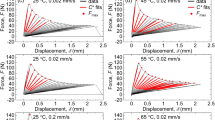Abstract
Interfacial toughness quantifies resistance to crack growth along an interface and in this investigation the toughness of an aluminum/epoxy interface was measured as a function of surface roughness and test temperature. The large strain response of the relatively ductile epoxy adhesive used in this study was also characterized. This epoxy adhesive exhibits intrinsic strain-softening after initial compressive yield and then deforms plastically at a roughly constant flow stress until it rapidly hardens at large compressive strains. We find that interface toughness scales as the product of the temperature dependent epoxy yield strength and a length scale that characterizes surface roughness. The proposed scaling is based upon dimensional considerations of a model problem that assumes that the characteristic length scale of both the roughness and the crack-tip yield zone is small relative to the region dominated by the linear elastic asymptotic crack-tip stress field. Furthermore, the model assumes that interfacial failure occurs only after the epoxy begins to harden at large strains. The proposed relationship is validated by our interfacial toughness measurements.















Similar content being viewed by others
References
Adolf DB, Chambers RS, Caruthers JM (2004) Extensive validation of a thermodynamically consistent, nonlinear viscoelastic model for glassy polymers. Polymer 45(13):4599–4621
Anderson TL (2005) Fracture mechanics: fundamentals and applications. CRC Press, Boca Raton
Bagheri R, Marouf BT, Pearson RA (2009) Rubber-Toughened Epoxies: a critical review. Polym Rev 49(3):201–225
Bao G, Ho S, Suo Z, Fan B (1992) The role of material orthotropy in fracture specimens for composites. Int J Solids Struct 29:1105–1116
Brown HR (1990) Mixed-mode effects on the toughness of polymer interfaces. J Mater Sci 25(6):2791–2794
Buckley CP, Harding J, Hou JP, Ruiz C, Trojanowski A (2001) Deformation of thermosetting resins at impact rates of strain. Part I: experimental study. J Mech Phys Solids 49:1517–1538
Hutchinson JW, Suo Z (1992) Mixed mode cracking in layered materials. In: Hutchinson JW, Wu TY (eds) Advances in applied mechanics. Academic Press, Cambridge, pp 63–191
Jennings CW (1972) Surface-roughness and bond strength of adhesives. J Adhes 4(1):25–38
Kinloch AJ (1980) The science of adhesion.1. Surface and interfacial aspects. J Mater Sci 15(9):2141–2166
Kinloch AJ (1982) The science of adhesion.2. Mechanics and mechanisms of failure. J Mater Sci 17(3):617–651
McClintock FA, Argon AS (1966) Mech Behav Mater. Addison-Wesley Pub. Co, Boston
Packham DE (2003) Surface energy, surface topography and adhesion. Int J Adhes Adhes 23:437–448
Pocius AV (1997) Adhes Adhes Technol. Hanser Gardner Publications Inc, Cincinnati
Reedy ED Jr, Guess TR (1993) Comparison of butt tensile strength data with interface corner stress intensity factor prediction. Int J Solids Struct 30:2929–2936
Reedy ED Jr, Guess TR (1995) Butt joint tensile strength: interface corner stress intensity factor prediction. J Adhes Sci Technol 9:237–251
Reedy ED Jr, Guess TR (1999) Additional interface corner toughness data for an adhesively-bonded butt joint. Int J Fract 98:L3–L8
Rice JR, Suo Z, Wang JS (1990) Mechanics and thermodynamics of brittle interfacial failure in bimaterial systems. In: Ruhle M, Evans AG, Ashby MF, Hirth JP (eds) Metal-ceramic interfaces. Pergamon Press, New York, pp 269–294
Rider AN, Arnott DR (2001) The influence of adherend topography on the fracture toughness of aluminum-epoxy adhesive joints in humid environments. J Adhes 75:203–228
Shahid M, Hashim SA (2002) Effect of surface roughness on the strength of cleavage joints. Int J Adhes Adhes 22(3):235–244
Stevens MJ (2001) Interfacial fracture between highly cross-linked polymer networks and a solid surface: effect of interfacial bond density. Macromolecules 34(8):2710–2718
Suo Z, Hutchinson JW (1989) Sandwich test specimens for measuring interface crack toughness. Mater Sci Eng A 107:135–143
Tvergaard V, Hutchinson JW (1993) The influence of plasticity on mixed mode interface toughness. J Mech Phys Solids 41:1119–1135
Volinsky AA, Moody NR, Gerberich WW (2002) Interfacial toughness measurements for thin films on substrates. Acta Materialia 50(3):441–466
Zhang YL, Spinks GM (1997) An atomic force microscopy study of the effect of surface roughness on the fracture energy of adhesively bonded aluminium. J Adhes Sci Technol 11(2):207–223
Zhang S, Panat R, Hsia KJ (2003) Influence of surface morphology on the adhesion strength of epoxy-aluminum interfaces. J Adhes Sci Technol 17:1685–1711
Acknowledgements
Sandia National Laboratories is a multimission laboratory managed and operated by National Technology and Engineering Solutions of Sandia, LLC., a wholly owned subsidiary of Honeywell International, Inc., for the U.S. Department of Energy’s National Nuclear Security Administration under contract DE-NA-0003525. This paper describes objective technical results and analysis. Any subjective views or opinions that might be expressed in the paper do not necessarily represent the views of the U.S. Department of Energy or the United States Government.
Author information
Authors and Affiliations
Corresponding author
Additional information
Publisher's Note
Springer Nature remains neutral with regard to jurisdictional claims in published maps and institutional affiliations.
Rights and permissions
About this article
Cite this article
Reedy, E.D., Stavig, M.E. Interfacial toughness: dependence on surface roughness and test temperature. Int J Fract 222, 1–12 (2020). https://doi.org/10.1007/s10704-019-00419-0
Received:
Accepted:
Published:
Issue Date:
DOI: https://doi.org/10.1007/s10704-019-00419-0




